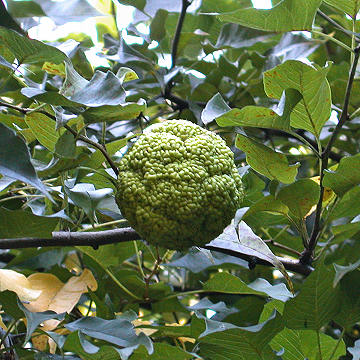

Maclura pomifera - (image 1 of 4)
Taxonomy
Family: Moraceae
Habitat
Rich, moist soil in thickets and old pastures.
Associates
Distribution
Native to AR, OK, and TX.
Morphology
Deciduous tree to 20 m. Twigs and petioles with milky sap. Bark dark orange-brown, deeply furrowed, scaly, thorny. Leaves alternate, lance-ovate, 6-12 cm, acuminate, petiolate; thorns stout, 1-2 cm. Dioecious; staminate flowers many in loose, globose to oblong, peduncles axillary heads, calyx 4-parted, stamens 4; pistillate flowers in dense, globose, axillary heads, the calyx 4-lobed and closely surrounding the ovary, with a filiform and elongate style. Fruit a yellowish-green, 6-12 cm diameter, hard, globose syncarp composed of the enlarged common receptacle and calyces; surface rind-like, marked by remnants of the calyces.
Notes
Flowers May and June.
Wetland indicator: Facultative Upland
Also called Hedge Apple. Widely planted as a hedge and naturalized far north of its natural range, this tree spreads by both seed and root suckers. The fruits are rich in latex and considered inedible, however they may have been eaten by now extinct megafauna (Barlow 2001). This might explain why this species had not managed to spread northward following the last glaciation, as it is well-adapted to northern climates.
References
Barlow, C. 2001. Anachronistic Fruits and the Ghosts Who Haunt Them. Arnoldia, 61( 2)
Gleason, Henry A. and A. Cronquist. 1991. Manual of Vascular Plants of
Northeastern United States
and Adjacent Canada. Second Ed.
The New York Botanical Garden. Bronx, NY
USDA, NRCS. 2002.
The PLANTS Database, Version 3.5 (http://plants.usda.gov).
National Plant Data Center, Baton Rouge, LA 70874-4490 USA.
|
Michael Hough © 2009 |